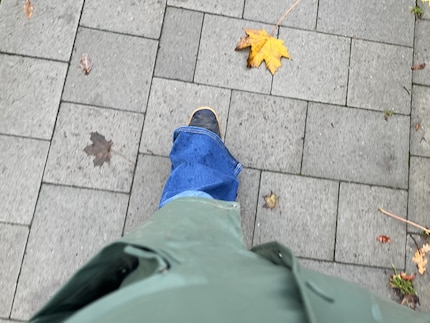
Background information
I did it! What happened when I attempted 10,000 steps a day
by Anna Sandner

Bye-bye, 10,000 steps! Hello, interval walking. The Japanese fitness trend promises maximum results with minimum effort. I tried it out, with unexpected results – and a good dose of sobering reality.
Forget 10,000 steps, check out this newest health trend straight outta East Asia: interval walking. And no, this isn’t a TikTok trend that some influencer came up with, but a scientifically researched method to improve your fitness extremely effectively. But let’s start at the beginning: who came up with it? Japan! More specifically, researchers from Shinshu University who had an idea years ago: «Why make things complicated when it can be simple?» To replace jogging for hours or struggling through 10,000 steps, Dr Hiroshi Nose and his team developed interval walking. By the way, 10,000 steps isn’t some magical scientific discovery. Instead, it comes from a 1960s advertising campaign for a pedometer – yes, really (article in German)!
First off, it’s not about simply collecting steps, but challenging your body in a targeted way. Studies on middle-aged and older people show that interval walking increases oxygen consumption, builds muscle and lowers blood pressure – in some cases as much as medication. It helps prevent common diseases such as diabetes and obesity, and it’s easier on the joints than jogging. Interval walking just four times a week is enough to improve your stamina and blood pressure – and it’s more effective than strolling for hours on end. This fits me quite well, since I usually don’t have much free time to spare.
Warm-up: walk normally for 5 minutes.
Intervals: 3 minutes of high intensity («I can’t talk any more!») ➔ 3 minutes of low intensity (a simple stroll). 5 repetitions/intervals ends up at 30 minutes.
Cool down: 5 minutes at a slower pace.
And best of all, you don’t need an app, gym or any equipment. Just your legs and a watch.
Sounds great, and so the idea for a new instalment of «I did it!» was born. At last, a fitness method that’s backed up by science and relatively quick to implement, requiring no additional tools and providing regular exercise outdoors. Even better, the clearly structured intervals make everything manageable and simple to calculate time-wise. For two weeks, I go out for half an hour every other day, alternating between brisk and relaxed walking. Sounds like the perfect blend of efficiency and minimalism on paper. The lazy part of me is already celebrating.
The first attempt already led to a realisation. Starting off, I still think three-minute slices are great: how long can three minutes really be? As it turns out, very, especially when it’s three high-intensity minutes. I’m constantly staring at the clock and waiting for salvation: finally, I can slow down again! The following three slow minutes are just enough to get my breath back, then I’m already back to the grind… Lacking any distractions – podcast, music or conversation – I feel every step. I’m already disillusioned after my first two attempts. The constant tempo changes are annoying, time passes at a snail’s pace and I never even come close to getting into a rhythm.

Before frustration sets in, I try a change of strategy: playing a podcast in the hope that time will pass quicker that way. Great in theory, but the tempo changes mess it up in practice. First, I walk so fast that I don’t even catch what they’re babbling about. Then when things get chill again, I concentrate on the podcast and miss my next change. Argh, I’m always getting mixed up. And annoyed again.
So I swap my podcast for music. That works better, at least on less focused days. Nevertheless, I just can’t get used to those three-minute intervals, and my base mood remains stressed. Absolutely not the result I wanted. Or expected.
So, time for the next idea: a motivation boost via friends? In the spirit of those Covid walks, I ask a friend if she’d like to accompany me. We meet every so often for walks, so why not make it a training session? Simple: having a conversation that lasts longer than three minutes is absolutely impossible. During intensive intervals we’re out of breath instantly, no time for stories there, and during slow ones we need to catch our breath first. I quickly realise that group walking intervals are horrible for social interaction. And they’re only fun if you’re not planning to have a conversation in the first place.
Routine is often the key to success. And some of the ideas I’ve tried out only won me over after a while. Unfortunately, things are different when it comes to interval walking. Instead of getting easier through habit, fast passages just feel longer and longer. Those tempo changes are a colossal pain in the neck, and after two weeks I’m finally fed up.
Let’s start with the positives: sure, the exercise was definitely good for me. I went out regularly, breathed fresh air, activated my muscles and got out of my office chair. To tell the truth, I felt a bit more alert and fitter too. However, this subjective effect probably has less to do with the training method itself and more with simply doing exercise outside. And I prefer getting that in the form of leisurely walks or, even better, forest baths.
My last few days were almost a countdown to a normalcy. I savoured the thought of simply setting off again – no stopping, no constant glances at my watch, no panting and silence among friends. Interval walking definitely has potential for fitness fans bored with monotonous walks. For me, it’ll remain a one-off self-experiment that granted me insight, but didn’t become a new favourite.
Still, maybe you’ll feel differently. Give it a try – or if you already have, tell us about your experience in the comments.
Check out some more of my experiments too:
Science editor and biologist. I love animals and am fascinated by plants, their abilities and everything you can do with them. That's why my favourite place is always the outdoors - somewhere in nature, preferably in my wild garden.
Interesting facts about products, behind-the-scenes looks at manufacturers and deep-dives on interesting people.
Show all
Background information
by Anna Sandner

Background information
by Anna Sandner

Background information
by Anna Sandner